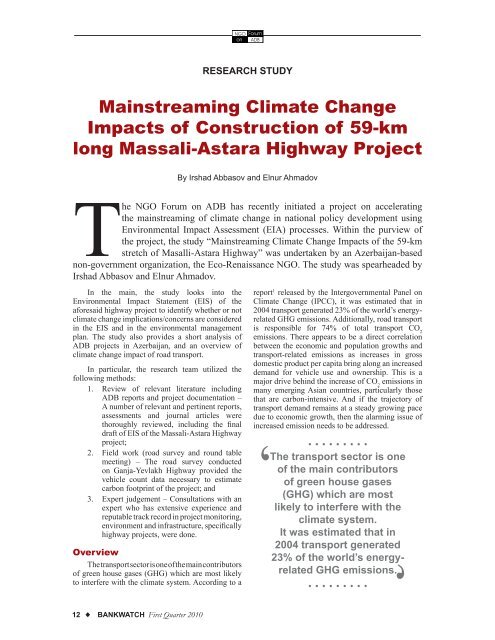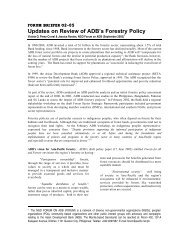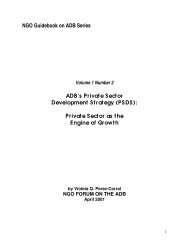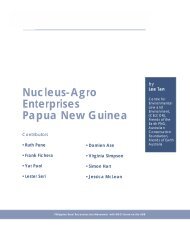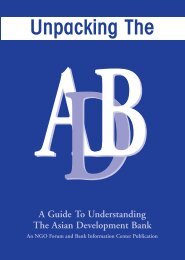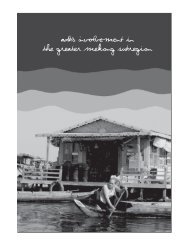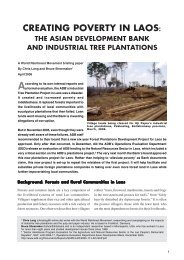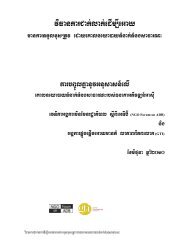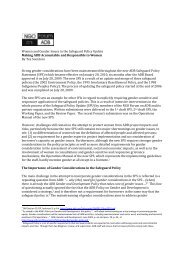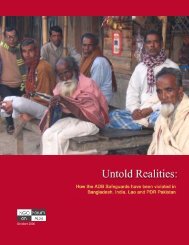Mainstreaming Climate Change Impacts of the Masalli-Astara Highway ...
Mainstreaming Climate Change Impacts of the Masalli-Astara Highway ...
Mainstreaming Climate Change Impacts of the Masalli-Astara Highway ...
You also want an ePaper? Increase the reach of your titles
YUMPU automatically turns print PDFs into web optimized ePapers that Google loves.
<strong>Mainstreaming</strong> <strong>Climate</strong> <strong>Change</strong><br />
<strong>Impacts</strong> <strong>of</strong> <strong>of</strong> Construction <strong>the</strong> <strong>Masalli</strong>-<strong>Astara</strong> <strong>of</strong> 59-km<br />
<strong>Highway</strong> Project<br />
12 BANKWATCH First Quarter 2010<br />
By Irshad Abbasov and Elnur Ahmadov<br />
The NGO Forum on ADB has recently initiated a project on accelerating<br />
<strong>the</strong> mainstreaming <strong>of</strong> climate change in national policy development using<br />
Environmental Impact Assessment (EIA) processes. Within <strong>the</strong> purview <strong>of</strong><br />
<strong>the</strong> project, <strong>the</strong> study “<strong>Mainstreaming</strong> <strong>Climate</strong> <strong>Change</strong> <strong>Impacts</strong> <strong>of</strong> <strong>the</strong> 59-km<br />
stretch <strong>of</strong> <strong>Masalli</strong>-<strong>Astara</strong> <strong>Highway</strong>” was undertaken by an Azerbaijan-based<br />
non-government organization, <strong>the</strong> Eco-Renaissance NGO. The study was spearheaded by<br />
Irshad Abbasov and Elnur Ahmadov.<br />
In <strong>the</strong> main, <strong>the</strong> study looks into <strong>the</strong><br />
Environmental Impact Statement (EIS) <strong>of</strong> <strong>the</strong><br />
aforesaid highway project to identify whe<strong>the</strong>r or not<br />
climate change implications/concerns are considered<br />
in <strong>the</strong> EIS and in <strong>the</strong> environmental management<br />
plan. The study also provides a short analysis <strong>of</strong><br />
ADB projects in Azerbaijan, and an overview <strong>of</strong><br />
climate change impact <strong>of</strong> road transport.<br />
In particular, <strong>the</strong> research team utilized <strong>the</strong><br />
following methods:<br />
1. Review <strong>of</strong> relevant literature including<br />
ADB reports and project documentation –<br />
A number <strong>of</strong> relevant and pertinent reports,<br />
assessments and journal articles were<br />
thoroughly reviewed, including <strong>the</strong> final<br />
draft <strong>of</strong> EIS <strong>of</strong> <strong>the</strong> Massali-<strong>Astara</strong> <strong>Highway</strong><br />
project;<br />
2. Field work (road survey and round table<br />
meeting) – The road survey conducted<br />
on Ganja-Yevlakh <strong>Highway</strong> provided <strong>the</strong><br />
vehicle count data necessary to estimate<br />
carbon footprint <strong>of</strong> <strong>the</strong> project; and<br />
3. Expert judgement – Consultations with an<br />
expert who has extensive experience and<br />
reputable track record in project monitoring,<br />
environment and infrastructure, specifically<br />
highway projects, were done.<br />
Overview<br />
The transport sector is one <strong>of</strong> <strong>the</strong> main contributors<br />
<strong>of</strong> green house gases (GHG) which are most likely<br />
to interfere with <strong>the</strong> climate system. According to a<br />
RESEARCH STUDY<br />
long Massali-<strong>Astara</strong> <strong>Highway</strong> Project<br />
report 1 released by <strong>the</strong> Intergovernmental Panel on<br />
<strong>Climate</strong> <strong>Change</strong> (IPCC), it was estimated that in<br />
2004 transport generated 23% <strong>of</strong> <strong>the</strong> world’s energyrelated<br />
GHG emissions. Additionally, road transport<br />
is responsible for 74% <strong>of</strong> total transport CO 2<br />
emissions. There appears to be a direct correlation<br />
between <strong>the</strong> economic and population growths and<br />
transport-related emissions as increases in gross<br />
domestic product per capita bring along an increased<br />
demand for vehicle use and ownership. This is a<br />
major drive behind <strong>the</strong> increase <strong>of</strong> CO 2 emissions in<br />
many emerging Asian countries, particularly those<br />
that are carbon-intensive. And if <strong>the</strong> trajectory <strong>of</strong><br />
transport demand remains at a steady growing pace<br />
due to economic growth, <strong>the</strong>n <strong>the</strong> alarming issue <strong>of</strong><br />
increased emission needs to be addressed.<br />
The transport sector is one<br />
<strong>of</strong> <strong>the</strong> main contributors<br />
<strong>of</strong> green house gases<br />
(GHG) which are most<br />
likely to interfere with <strong>the</strong><br />
climate system.<br />
It was estimated that in<br />
2004 transport generated<br />
23% <strong>of</strong> <strong>the</strong> world’s energyrelated<br />
GHG emissions.
The Project in Focus<br />
The ADB-funded <strong>Masalli</strong>-<strong>Astara</strong> <strong>Highway</strong><br />
project is part <strong>of</strong> <strong>the</strong> Sou<strong>the</strong>rn Road Corridor<br />
Improvement project. The Azerbaijan Ministry <strong>of</strong><br />
Transport developed a Road Network Development<br />
Program for 2006–2015 which considers construction,<br />
upgrade and rehabilitation <strong>of</strong> 3570 km <strong>of</strong> 64 state<br />
roads and 5928 km <strong>of</strong> 58 secondary roads. 2<br />
The project includes not only construction <strong>of</strong> <strong>the</strong><br />
approximately 59 km-long, 4-lane <strong>Masalli</strong>-<strong>Astara</strong><br />
<strong>Highway</strong>, but also rehabilitation <strong>of</strong> local roads in <strong>the</strong><br />
project area, installation <strong>of</strong> vehicle weighing station<br />
and o<strong>the</strong>r equipment, as well as capacity building for<br />
an executing agency. The project is funded through<br />
ADB`s multitranche financing facility mechanism.<br />
According to <strong>the</strong> project implementation schedule, 3<br />
<strong>the</strong> project start and estimated finish dates are May<br />
2007 and December 2010 respectively.<br />
<strong>Climate</strong> <strong>Change</strong> Considerations<br />
in <strong>the</strong> ADB-funded Projects<br />
Seem Wanting<br />
• Significant Gaps in <strong>the</strong> Environmental<br />
Impact Statement<br />
It is interesting to note that significant gaps are<br />
evident in <strong>the</strong> project. A review <strong>of</strong> <strong>the</strong> final draft EIS<br />
<strong>of</strong> <strong>the</strong> highway project reveals that <strong>the</strong>re is no clear<br />
mention <strong>of</strong> climate change impacts that <strong>the</strong> highway<br />
project is likely to contribute. By and large, <strong>the</strong><br />
EIS report is considered inadequate when it comes<br />
to <strong>the</strong> assessment and mitigation <strong>of</strong> likely adverse<br />
environmental impacts as well as climate change<br />
effects.<br />
• The Country Strategy and Program <strong>of</strong> 2006<br />
A closer look into <strong>the</strong> lending portfolio <strong>of</strong><br />
Azerbaijan reveals that 45% <strong>of</strong> total cumulative<br />
lending (US$ 810.03 million as <strong>of</strong> November 2009)<br />
was allocated to <strong>the</strong> transport sector, and more than<br />
95% was directed to road/highway improvement and<br />
development projects. The figures are consistent with<br />
<strong>the</strong> ADB’s posturing in Azerbaijan in that <strong>the</strong> former<br />
plays an important role in <strong>the</strong> latter’s transport sector,<br />
particularly in <strong>the</strong> development <strong>of</strong> roads.<br />
Azerbaijan joined ADB in 1999. Initially,<br />
<strong>the</strong> ADB led its operations through an Interim<br />
Operations strategy, which was later replaced by<br />
a Country Strategy and Program (CSP) <strong>of</strong> 2006.<br />
ADB has several programs and initiatives on<br />
climate change and transport such as <strong>the</strong> Sustainable<br />
Transport Initiative throughout Asia and <strong>the</strong> Pacific.<br />
Interestingly, <strong>the</strong> CSP <strong>of</strong> 2006 is quite superficial<br />
when it comes to dealing with climate change in<br />
Azerbaijan. The strategy tries to align itself with<br />
<strong>the</strong> government’s programs and development goals 4<br />
which may or may not put climate change at <strong>the</strong><br />
forefront <strong>of</strong> its relevant policies as <strong>the</strong>re are o<strong>the</strong>r<br />
pressing national or local issues to address. The only<br />
sectors that <strong>the</strong> ADB intervention will benefit, from<br />
Sections <strong>of</strong> EIS Notes<br />
Description <strong>of</strong><br />
<strong>the</strong> environment<br />
Alternative<br />
options<br />
Likely<br />
environmental<br />
impacts and<br />
mitigation<br />
measures<br />
Public<br />
consultations<br />
Appendix<br />
Environmental<br />
Management<br />
Plan<br />
<br />
<br />
<br />
This section considers <strong>the</strong><br />
baseline climatic conditions,<br />
including amount <strong>of</strong> precipitation,<br />
atmospheric humidity, and o<strong>the</strong>r<br />
characteristics.<br />
There is a discussion <strong>of</strong> historic<br />
fluctuations <strong>of</strong> <strong>the</strong> Caspian sea<br />
level, as well as concern for its<br />
future rise.<br />
The section also describes<br />
tree species, shrubs and grass<br />
plants which will be affected. It is<br />
estimated that around 328 trees<br />
(age distribution 7 – 65 years)<br />
will be lost.<br />
Only loss <strong>of</strong> trees and distance to<br />
protected areas are considered under<br />
<strong>the</strong> environmental criterion.<br />
<br />
<br />
There is no clear statement about<br />
<strong>the</strong> contribution <strong>of</strong> <strong>the</strong> road project<br />
to GHG and, consequently, to<br />
climate change in <strong>the</strong> region.<br />
An assessment <strong>of</strong> impacts on<br />
ambient air is very superficial<br />
(brief qualitative statement).<br />
Main concerns identified were<br />
compensation and resettlement, as<br />
well as passage across <strong>the</strong> road. No<br />
environmental concerns were raised.<br />
Considers an <strong>of</strong>fset program – an<br />
intensive tree-planting program<br />
<strong>the</strong> perspective <strong>of</strong> climate change (CC) mitigation<br />
and adaptation, are <strong>the</strong> energy and water sectors.<br />
In <strong>the</strong> energy sector, <strong>the</strong> CSP considers lending for<br />
projects to promote <strong>the</strong> use <strong>of</strong> renewable energy<br />
sources which are one <strong>of</strong> <strong>the</strong> essential means to<br />
shift to a carbon-free or less intensive economy. In<br />
<strong>the</strong> water sector, <strong>the</strong> CSP mentions ADB approval<br />
<strong>of</strong> a flood mitigation project which is a strategic<br />
investment toward building Azerbaijan’s capacity<br />
for adaptation to likely adverse consequences <strong>of</strong><br />
climate change in years ahead.<br />
In addition, <strong>the</strong> CSP notes that Azerbaijan<br />
joined ADB`s Renewable Energy Generation,<br />
Energy Efficiency and GHG Abatement project.<br />
This is a welcome step towards efforts to reduce and<br />
avoid GHG generation in <strong>the</strong> country. Therefore, it<br />
is strongly recommended that <strong>the</strong> CSP <strong>of</strong> 2006 be<br />
reviewed to incorporate climate change concerns<br />
into priority development sectors. Alternatively,<br />
First Quarter 2010 BANKWATCH<br />
13
ADB could develop sector-specific strategies to<br />
address particular concerns and needs <strong>of</strong> individual<br />
sectors <strong>of</strong> <strong>the</strong> economy in Azerbaijan.<br />
Directing investment into construction and<br />
improvement <strong>of</strong> roads is considered as a traditional<br />
approach in <strong>the</strong> development <strong>of</strong> <strong>the</strong> transport sector 5 ,<br />
which needs to be changed if a sustainable transport<br />
sector is to be achieved. Never<strong>the</strong>less, this traditional<br />
approach has been <strong>the</strong> focus <strong>of</strong> ADB funding over<br />
<strong>the</strong> past decade, despite <strong>the</strong> fact that road transport<br />
is viewed as one <strong>of</strong> <strong>the</strong> chief and growing GHGemitting<br />
sectors.<br />
The transport sector in Azerbaijan does need<br />
investment; however, this should be directed at<br />
transport modes with low carbon emissions. In<br />
addition, <strong>the</strong>re are numerous project ideas to embark<br />
on such as fuel diversification (e.g., setting up <strong>of</strong><br />
bi<strong>of</strong>uels plants, encouragement <strong>of</strong> o<strong>the</strong>r transport<br />
modes for passenger and freight hauls, transport<br />
demand management, and so on).<br />
Directing investment<br />
into construction and<br />
improvement <strong>of</strong> roads<br />
is considered as a<br />
traditional approach in<br />
<strong>the</strong> development <strong>of</strong> <strong>the</strong><br />
transport sector, which<br />
needs to be changed if<br />
a sustainable transport<br />
sector is to be achieved.<br />
• Tracing Carbon Footprint<br />
As part <strong>of</strong> <strong>the</strong> present study, we also attempted<br />
to roughly estimate a carbon footprint <strong>of</strong> <strong>the</strong> highway<br />
project over its entire lifetime. There are a number<br />
<strong>of</strong> assumptions built into <strong>the</strong> carbon footprint (CF)<br />
estimate. First <strong>of</strong> all, vehicle activity data (average<br />
daily count) by vehicle categories come from Ganja<br />
–Yevlakh <strong>Highway</strong> which is almost operational<br />
and <strong>of</strong> similar capacity as <strong>the</strong> yet-to-be-completed<br />
<strong>Masalli</strong>-<strong>Astara</strong> <strong>Highway</strong>. These data tell us how<br />
much traffic is to be expected when <strong>the</strong> <strong>Masalli</strong>-<br />
<strong>Astara</strong> <strong>Highway</strong> Project is completed and enters <strong>the</strong><br />
operational phase.<br />
Secondly, due to <strong>the</strong> lack or inaccessibility <strong>of</strong><br />
information about CO 2 emission factors <strong>of</strong> existing<br />
vehicle types in Azerbaijan, we considered <strong>the</strong> target<br />
emission factor to be achieved by EU Member<br />
States by 2012. 6 In o<strong>the</strong>r words, our CF estimate is<br />
quite conservative as current CO 2 emissions per unit<br />
<strong>of</strong> distance traveled <strong>of</strong> vehicles in Azerbaijan are<br />
relatively higher than <strong>the</strong> used target factor.<br />
14 BANKWATCH First Quarter 2010<br />
Thirdly, CO 2 contribution <strong>of</strong> <strong>the</strong> construction<br />
phase is assumed to constitute less than 20% <strong>of</strong> <strong>the</strong><br />
annual amount generated by <strong>the</strong> road operation.<br />
Finally, <strong>the</strong> overall life <strong>of</strong> <strong>the</strong> road project is assumed<br />
to constitute 50 years.<br />
As per <strong>the</strong> 1 st Azerbaijan National Communication<br />
to UNFCCC, CO 2 emissions from motor transport in<br />
<strong>the</strong> country in 1990 are estimated at 3668 000 tonnes<br />
<strong>of</strong> CO 2 . This figure dropped to 3044 000 tonnes <strong>of</strong><br />
CO 2 in 1994 7 . So, when compared to <strong>the</strong> 1994 total<br />
in country CO 2 emissions, <strong>the</strong> <strong>Masalli</strong>-<strong>Astara</strong> Road<br />
project represents a small number, around 2.2%.<br />
However, it should be noted that CF estimates<br />
for <strong>the</strong> road project are made under conditions<br />
<strong>of</strong> global economic and financial crisis. In future<br />
years, depending on <strong>the</strong> status <strong>of</strong> trade turnover<br />
between Russia and Iran and <strong>the</strong> economic growth<br />
in Azerbaijan, it is expected that <strong>the</strong> <strong>Masalli</strong>-<strong>Astara</strong><br />
<strong>Highway</strong> will be intensively used and thus, its<br />
contribution to <strong>the</strong> total in-country GHG emissions<br />
will grow.<br />
Conclusions and Recommendations<br />
• CC is one <strong>of</strong> <strong>the</strong> greatest threats faced<br />
by <strong>the</strong> world, with <strong>the</strong> transport sector<br />
contributing around 1/5 <strong>of</strong> total worldwide<br />
GHG emissions.<br />
• There is a close association between<br />
economic growth and transport demand.<br />
• To achieve a drastic reduction in GHG,<br />
which are mostly CO 2 emissions from <strong>the</strong><br />
transport sector, alternative policies need to<br />
be adopted with a special focus on transport<br />
demand management.<br />
• CC poses various undesirable implications<br />
which will impact almost all sectors <strong>of</strong> <strong>the</strong><br />
economy and will exacerbate health risks<br />
and bring economic losses.<br />
• Although CC and its impacts are recognized<br />
by almost all multilateral development<br />
banks including ADB, <strong>the</strong>se concerns/<br />
considerations are nei<strong>the</strong>r clearly articulated<br />
in <strong>the</strong> ADB-prepared Azerbaijan Country<br />
Strategy and Program <strong>of</strong> 2006, nor in <strong>the</strong><br />
final draft EIS <strong>of</strong> <strong>the</strong> highway project.<br />
• Moreover, despite <strong>the</strong> fact that road<br />
transport is increasingly contributing to<br />
GHG emissions, ADB has kept investing<br />
in <strong>the</strong> Azerbaijan transport sector, with<br />
more than 95% <strong>of</strong> <strong>the</strong> total transport sectordirected<br />
investment going to road/highway<br />
improvement and construction projects.<br />
• Even though <strong>the</strong> carbon footprint <strong>of</strong><br />
<strong>the</strong> highway project is minimal (around<br />
2.2%) when compared to in-country road<br />
transport CO 2 emissions, it is expected that<br />
CO 2 contribution <strong>of</strong> <strong>the</strong> highway project<br />
will grow as trade links between Russia and<br />
Iran become stronger.
• The final draft EIS does not fully assess<br />
environmental impacts <strong>of</strong> <strong>the</strong> highway<br />
project, and most importantly, climate<br />
change concerns are not clearly addressed.<br />
• Results <strong>of</strong> <strong>the</strong> round table meeting point out<br />
to <strong>the</strong> need for wider disclosure <strong>of</strong> project<br />
information such as EIS, final route designs,<br />
and o<strong>the</strong>r related information.<br />
Recommendations<br />
• The important role played by international<br />
organizations in adopting a democratic EIA<br />
process in Azerbaijan is underscored 8 which<br />
means that similar changes can be brought<br />
about in <strong>the</strong> context <strong>of</strong> mainstreaming<br />
CC impacts in <strong>the</strong> country. Therefore,<br />
incorporation <strong>of</strong> CC considerations/<br />
concerns into <strong>the</strong> CSP <strong>of</strong> 2006 and revision<br />
<strong>of</strong> <strong>the</strong> priority sectors for ADB lending is<br />
highly recommended. This will help address<br />
CC impacts and build CC adaptation<br />
capacity in Azerbaijan.<br />
• ADB should mainstream not only CC<br />
adaptation measures into its policies but<br />
also require <strong>the</strong> assessment <strong>of</strong> CC impacts<br />
<strong>of</strong> proposed development projects by<br />
national executing agencies.<br />
• Fur<strong>the</strong>r lending efforts in <strong>the</strong> transport<br />
sector should be directed towards transport<br />
Endnotes:<br />
modes with lower or zero GHG emissions<br />
as well as cover such aspects as transport<br />
demand management, fuel diversification,<br />
and infrastructure for non-motorized<br />
transport means.<br />
• ADB should do more to ensure that projectrelevant<br />
information, including EIS, is<br />
available, timely, and accessible to all<br />
stakeholders in <strong>the</strong> Azerbaijani language.<br />
• Finally, it is highly recommended that<br />
ADB ensure <strong>the</strong> accountability <strong>of</strong> national<br />
executing agencies through frequent field<br />
visits and meetings with affected people.<br />
Mr. Irshad Abbasov and Mr. Elnur Ahmadov<br />
are working for <strong>the</strong> “Eco-Renaissance” Public<br />
Union NGO. Founded in 2004, <strong>the</strong> Eco-Renaissance<br />
was founded by a group <strong>of</strong> scientists from Ganja<br />
Regional Scientific Center and some intellectuals<br />
<strong>of</strong> Ganja city. The mission <strong>of</strong> <strong>the</strong> organization is to<br />
support <strong>the</strong> development <strong>of</strong> civil society in Azerbaijan<br />
by means <strong>of</strong> contributing to <strong>the</strong> solution <strong>of</strong> local as<br />
well as global environmental problems, promoting<br />
environmental education and raising awareness in<br />
<strong>the</strong> Western region <strong>of</strong> Azerbaijan. Mr. Abbasov is<br />
<strong>the</strong> director <strong>of</strong> Eco-renaissance. He has a doctorate<br />
degree in chemistry. Mr. Ahmadov has a masters<br />
degree in environment.<br />
1 Intergovernmental Panel on <strong>Climate</strong> <strong>Change</strong> (IPCC) (2007). <strong>Climate</strong> <strong>Change</strong> 2007: Mitigation <strong>of</strong> <strong>Climate</strong><br />
<strong>Change</strong>, Fourth Assessment Report. Cambridge University Press, Cambridge, United Kingdom and New<br />
York, NY, USA. http://www.ipcc.ch/publications_and_data/ar4/wg3/en/contents.html<br />
2 Technical Assistance Republic <strong>of</strong> Azerbaijan: Preparing <strong>the</strong> Sou<strong>the</strong>rn Road Corridor Improvement<br />
Project. Manila, Philippines. Asian Development Bank. http://www.adb.org/Documents/TARs/AZE/39176-<br />
AZE-TAR.pdf<br />
3 Azerbaijan: Multitranche Financing Facility for <strong>the</strong> Road Network Development Program. Project<br />
Administration Memorandum. Asian Development Bank. 2007. http://www.adb.org/Documents/PAMs/<br />
AZE/39176-AZE-PAM.pdf<br />
4 The approach <strong>of</strong> aligning its operations with <strong>the</strong> government development strategies is also explicitly<br />
stated in <strong>the</strong> ADB Fact Sheet for Azerbaijan.<br />
5 Understanding and Responding to <strong>Climate</strong> <strong>Change</strong> in Developing Asia. Asian Development Bank. 2009.<br />
http://www/adb.org/Documents/CSPs/AZE/2005/default.asp?p=ctryaze<br />
6 European Environment Agency and Office for Official Publications <strong>of</strong> <strong>the</strong> European Communities.<br />
2008. <strong>Climate</strong> for a transport change. TERM 2007: Indicators tracking transport and environment in <strong>the</strong><br />
European Union. Copenhagen, Denmark. http://www.eea.europa.eu/publications/eea_report_2008_1<br />
7 Azerbaijan State Committee on Hydrometeorology. 2001. 1 st National Communication to UNFCCC. Baku,<br />
Azerbaijan. http://unfccc.int/resource/docs/natc/azenc1.pdf<br />
8 Safarav S. 2000. Sovremennaya tendenziya izmeneniya temperaturi vozduxa I atmosfernix osadkov v<br />
Azerbaijane [Current trends in change <strong>of</strong> air temperature and atmospheric precipitation in Azerbaijan].<br />
Elm, Baku, Azerbaijan.<br />
First Quarter 2010 BANKWATCH<br />
15


